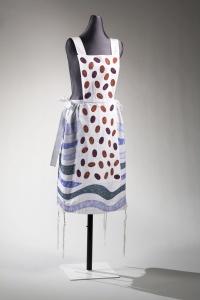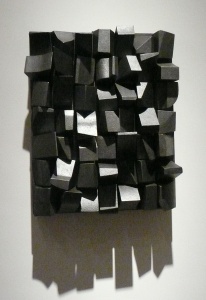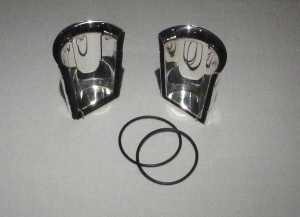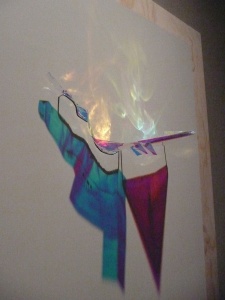Reinventing Ritual at The Jewish Museum
Why would one want to reinvent a Jewish ritual when it had been working perfectly well for hundreds if not thousands of years? Ah ha, perhaps all is not as well as traditionalists would like to think. There is the disquieting phenomenon that perhaps the majority of the Jewish people have little or no engagement with Jewish practice.
In this light the desire to reinvent is a positive attempt to reconnect. In these days of teshuva, reconnecting is nothing less than essential. That is one of the many themes in the ambitious exhibition at the Jewish Museum, Reinventing Ritual: Contemporary Art and Design for Jewish Life, currently on view until February 7, 2010.
Curator Daniel Belasco asserts “all Jewish ritual is ancient and contemporary, familiar and radical.” In this light he has assembled almost 60 works by 58 artists that challenge, transform, and invent Jewish ritual. “The power of ritual is its special metaphorical resonance that produces meaning in transformations of contemporary life.” The talis katan is a good example in that wearing it not only affirms a relationship to God; i.e. obedience and remembrance of mitzvot, but also establishes an affirmation between individuals; it signals religious observance to others. If it is tied with techeles yet another statement is made affirming that small but growing community.

In this context Rachel Kanter’s Fringed Garment (2005) is especially revealing. Based upon the textual precedent found in Menachot 43a in which “Rab Judah attached fringes to the aprons of [the women of] his household,” Kanter has created an entire series of garments based on traditional women’s aprons fashioned into four cornered garments and then attached with tzitzis. In Danya Ruttenberg’s catalogue essay she comments on Kanter’s work that it is “dramatically juxtaposing two seeming extremes–an apron, the ultimate symbol of domesticity and the home sphere with which women in Judaism have been associated; and tzitzit, a positive, time-bound mitzvah, the category of which carries connotations of men’s power in the public sphere.” Most fascinating is that the work is ultimately based on a Gemara, appropriated by a contemporary feminist and codified in an artwork. It does what all good art does, forcing us to reassess the reality and roots of a Jewish practice.
While a bare majority of the artists are women, the preoccupation with feminism and the challenging of traditional gender roles is not surprising. The very mandate of the exhibition is to be a “guidebook to the most current trends in contemporary Jewish art and design.” In the catalogue Tamar Rubin presents an extremely illuminating “Cultural Timeline 1994-2008” that traces the rise of Jewish-interest radical and traditional culture. Ma’yan: The Jewish Women’s Project holds its first women’s seder in 1994, The Knitting Factory in Manhattan hosts its first Downtown seder in 1996, Jewish Orthodox Feminist Alliance is born in 1997, Avoda Arts, a project to integrate art and Jewish learning is founded in 1999, Shabbat Across America (1997) and Birthright Israel (2000) reach out to thousands of unaffiliated Jews, the group Golem formed in 2001 to perform klezmer music with a rock sensibility, Heeb, the magazine, first publishes in 2002, Nextbook is created in 2004 to promote Jewish ideas, culture and literature, Atara, The Arts and Torah Association for Religious Artists is founded in 2007; all this and much more is traced in 14 years of radical and traditional ideas reaching out to a larger and larger Jewish audience. Reinventing Ritual is very much a reflection of this history.

Tobi Kahn’s Saphyr (2002) is a rather unique Omer counter. Each of the 49 days has a peg that goes into its socket. The wooden pegs are sculpted in unique shapes, each a different miniature sculpture that in its own way represents the uniqueness of each day as we perform God’s commandments. Here counting becomes a physical act, forcing us to feel the difference of each day and place it in the next slot. This very uniqueness comes together as we count; “The counting of the Omer represents the relationship between a person and his or her community. Beginning with one, we become an ordered multitude.” Kahn’s message is direct; each day and each person counts.

Among the works that transform and enhance existing Jewish ritual is Wedding Cup (2004) by the Israeli Bruria Avidan. As we all know under the chuppah the couple twice drinks from a cup of wine. In some traditions that date back to the Middle Ages, two separate cups are used. Here the utility of a wine cup is transformed into an elegant metaphor reflecting what is actually occurring. The artwork is two equal halves of a silver wine cup. As the ceremony is begun they are joined together with two rubber binders, closing the silicone seal and making one complete beautiful wine cup. By actually ‘making’ the two halves into one whole the couple is performing a unification, symbolic of the unification of man and woman in Jewish marriage and their unity with the Jewish people. One hopes that this reinvented ritual, simple and yet so beautiful and meaningful, will soon become part of every Jewish wedding.
Some types of creativity in these reinvented ritual objects are buried beneath many levels of image and allusion, requiring much excavation to extract the meaning. Some offer polemical declarations on sexism, environmentalism, biopolitics or social justice, frequently blunting or ignoring aesthetic enjoyment.

Other reinvented ritual objects release their pleasures with an immediate understanding. Gardening Sukkah (2000) by Allan Wexler is this kind of object that brings an instant smile. The artist ingeniously combined a gardening shed with a succah. The shed is built to contain all the tools he needs to hoe, rake, plant and prune in his garden. It even has wheels to facilitate moving from one side of his property to another. And when he came to the roof, he designed it to be retractable, especially structured to accommodate schach for the holiday of Succah. The shed has a built in table with chairs to accommodate holiday meals and wall storage for plates, glasses, silverware and all else one needs for a Yom Tov feast. What a delight!

Equally delightful in its transformative value is Cheselyn Amato’s Eternal Light (2003). The ner tamid is ubiquitous in all synagogues as a remembrance of the menorah positioned in the Holy Temple and its light, always burning, as “testimony to mankind that the Divine Presence always rests in Israel” (Shabbos 22b). Over the centuries the form of the lamp has taken many guises but the light is always the same; a flame created by burning oil and later, electricity. Amato transforms the flame itself into an ethereal display of pure colored light. In a curious way the ‘lamp’ itself becomes insubstantial, consisting only of wire holding a flexible commercial plastic film. This film has the unique ability to both reflect and filter the light that is shone on the reinvented ner tamid. The effect is magical, casting a beautiful colored shadow on the wall as it reflects a mystical two-colored reflection on the wall above. Amato’s work has transformed an elusive and fearful element, fire, into pure light as her powerful metaphor for God’s spirituality.
The enjoyment of this exhibition rests in not only the sheer scope and plentitude of its creativity, but more importantly in the fact that makes us reconnect to Jewish ritual in totally unexpected ways. The next time we see a ner tamid in synagogue, enter a succah, watch bride and groom under the chuppah, count the omer and even put on a talis katan, we should have at the very least a different appreciation of what we are doing and with what ritual objects we are connecting to our Jewish history, past, present and future.
Reinventing Ritual at The Jewish Museum
Jewish Museum
1109 Fifth Avenue, New York, N.Y.
www.thejewishmuseum.org